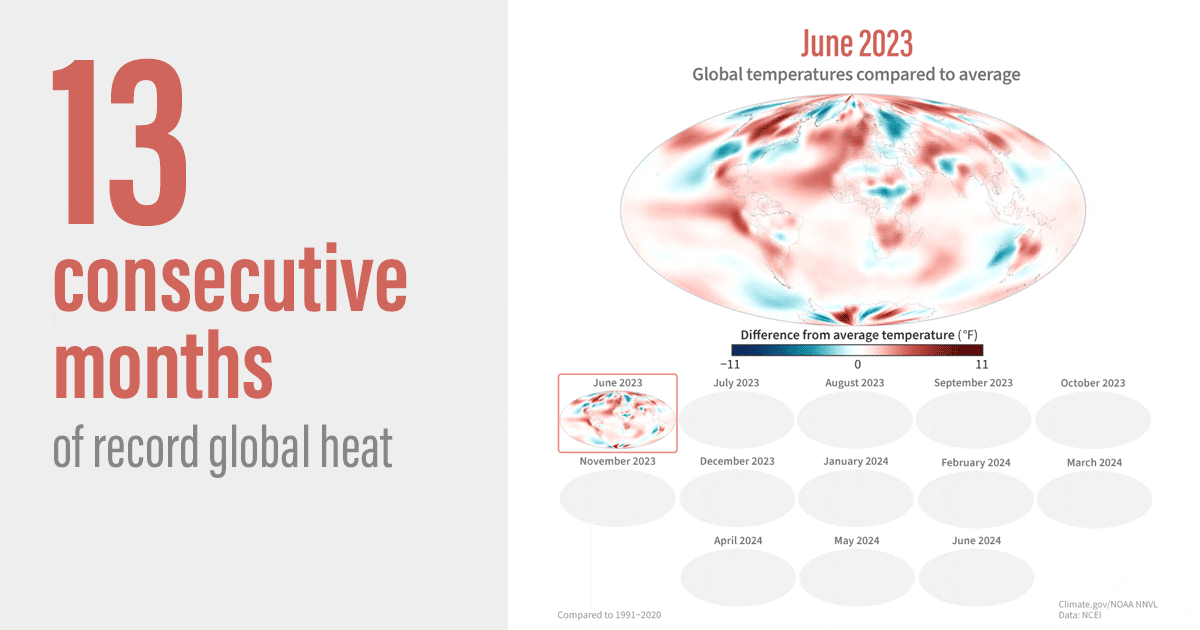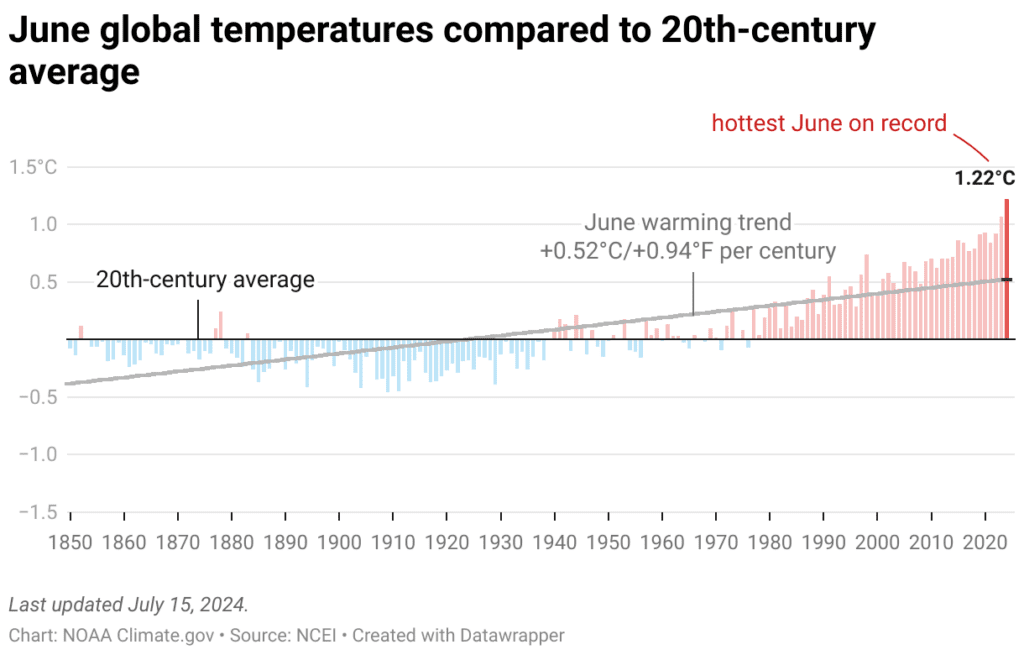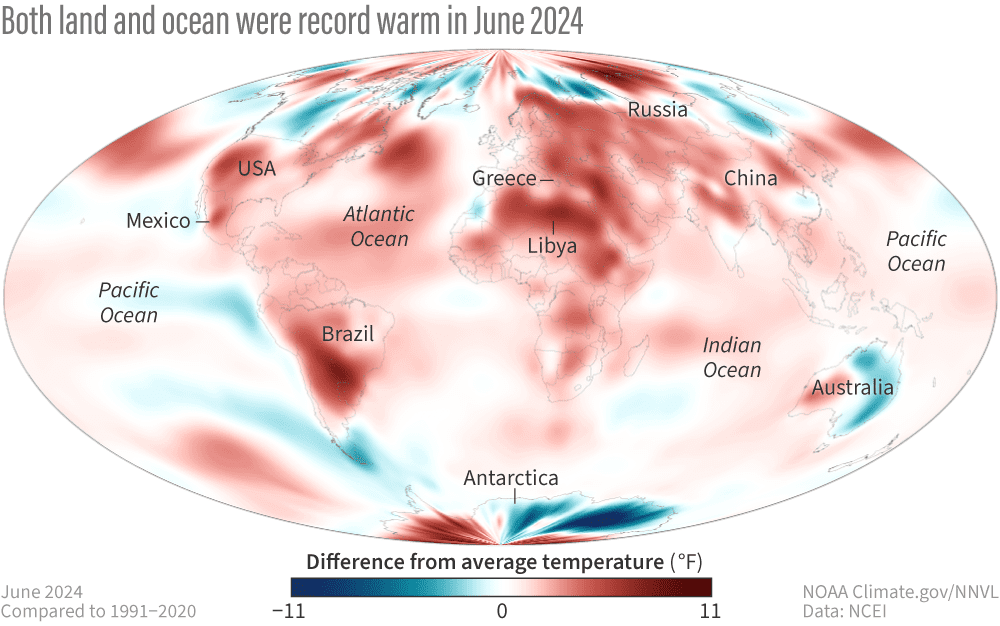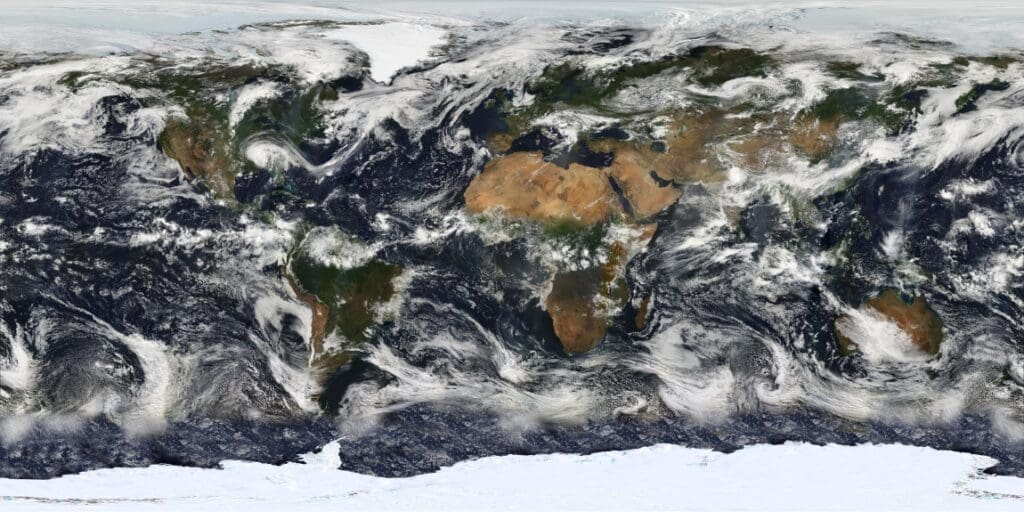By NOAA National Centers for Environmental Information and Global Precipitation Climatology Project | University of Maryland
Highlights
- Temperatures were above average over much of the globe with Africa, Asia and South America having their warmest June on record.
- Sea surface temperatures were record warm for the 15th consecutive month.
- Northern Hemisphere snow cover extent and global sea ice extent were both below average.
- Global tropical cyclone activity was below average, with only two named storms.
June temperature
June 2024 was the warmest June on record for the globe in NOAA’s 175-year record. The June global surface temperature was 1.22°C (2.20°F) above the 20th-century average of 15.5°C (59.9°F). This is 0.15°C (0.27°F) warmer than the previous June record set last year, and the 13th consecutive month of record-high global temperatures. This ties with May 2015-May 2016 for the longest record warm global temperature streak in the modern record (since 1980). June 2024 marked the 48th consecutive June with global temperatures, at least nominally, above the 20th-century average.

Global land-only June temperature also was warmest on record at 1.75°C (3.15°F) above average. The ocean-only temperature also ranked warmest on record for June at 0.98°C (1.76°F) above average, 0.05°C (0.09°F) warmer than the previous record warm June last year, and the 15th-consecutive monthly ocean record high. These record temperatures occurred under ENSO-neutral conditions. According to NOAA’s Climate Prediction Center, ENSO-neutral conditions are present and La Niña is favored to develop during July-September (65% chance) and persist into the Northern Hemisphere winter 2024-25 (85% chance during November-January).
June global temperatures compared to 20th-century average

Record-warm June temperatures covered large parts of Africa, parts of southern Europe, Southeast Asia, and much of the northern two-thirds of South America. Anomalous warmth also covered large parts of North America, with the exception of central and western Canada. During June 2024, 14.5% of the world’s surface had a record-high June temperature, exceeding the previous June record set in 2023 by 7.4%. Across the global land, 13.8% of its surface had a record-high June temperature. Meanwhile, 0.3% of the global land and ocean surface experienced a record-cold June temperature.
The record-warm June temperatures which were a continuation of record warmth throughout the first half of the year in large parts of South America contributed to early and expansive drying of the Pantanal, the world’s largest tropical wetlands. This led to a record start to the fire season, with more than 2500 wildfires reported in the Pantanal in June, the most ever for the month since records began in 1998, and more than six times the number in the same month of 2020, which was the most active fire year on record for the Pantanal.
In other parts of the world, monthly temperature anomalies exceeding +2°C to 3°C covered areas including large parts of eastern Europe, North Africa, northern Argentina, and large parts of central and western Asia. In Greece, an early-season heat wave with multi-day temperature exceedances of 38ºC (100ºF) occurred in many places. The extreme heat led to the reported deaths of several tourists and forced the closure of some tourist sites during the hottest periods.
June temperatures more than 3°C above average also covered much of western Antarctica. Conversely, temperatures below the 1991—2020 mean occurred in most of Greenland, southern South America, northwestern Russia, eastern Asia, eastern Australia, and much of eastern Antarctica.

Over the global oceans record-warm June temperatures covered large parts of the equatorial Atlantic and the Caribbean, where Hurricane Beryl became the first Category 4 hurricane observed in the Atlantic Ocean during the month of June. Record-warm sea surface temperatures also occurred in parts of the equatorial western Pacific, the southeast Pacific, and the Indian Ocean. Across the global ocean, 14.8% of its surface had a record-high temperature for the month. Only 0.2% of the global ocean was record cold in June. Widespread areas of below-average June sea surface temperatures were largely confined to the southeastern Pacific.
In the Northern Hemisphere, June 2024 ranked warmest on record at 1.56°C (2.81°F) above average, 0.32°C (0.58°F) warmer than the previous June record of 2023. The Northern Hemisphere land temperature and ocean temperature also each ranked warmest on record for the month. The Southern Hemisphere experienced its second warmest June on record at 0.88°C (1.58°F) above average, 0.02°C (0.04°F) cooler than 2023. The Southern Hemisphere land temperature for June was third warmest while June’s ocean temperature was second warmest on record.
June precipitation from land-based stations
June was drier-than-average in areas that included most of the western United States and Alaska, large parts of the far eastern United States, an area stretching from northern Africa to southeastern Europe, the United Kingdom, large parts of eastern Russia, northeastern China, and parts of southern and eastern Australia. Areas that were wetter-than-average in June included parts of southern Japan, areas of eastern Europe, much of western Australia, large parts of the central United States, and southeast China, where in Guangdong Province heavy rainstorms caused loss of homes, roadways and bridges, damage to crops and dozens of reported deaths and missing persons.

For information on 2024’s year-to-date temperature ranking, notable climate events, and separate statistics for Earth’s land and ocean areas see the full June 2024 monthly report from NOAA NCEI.
Read more here
More information: NOAA Press Release/Material Featured image credit: Javier Miranda | Unsplash




